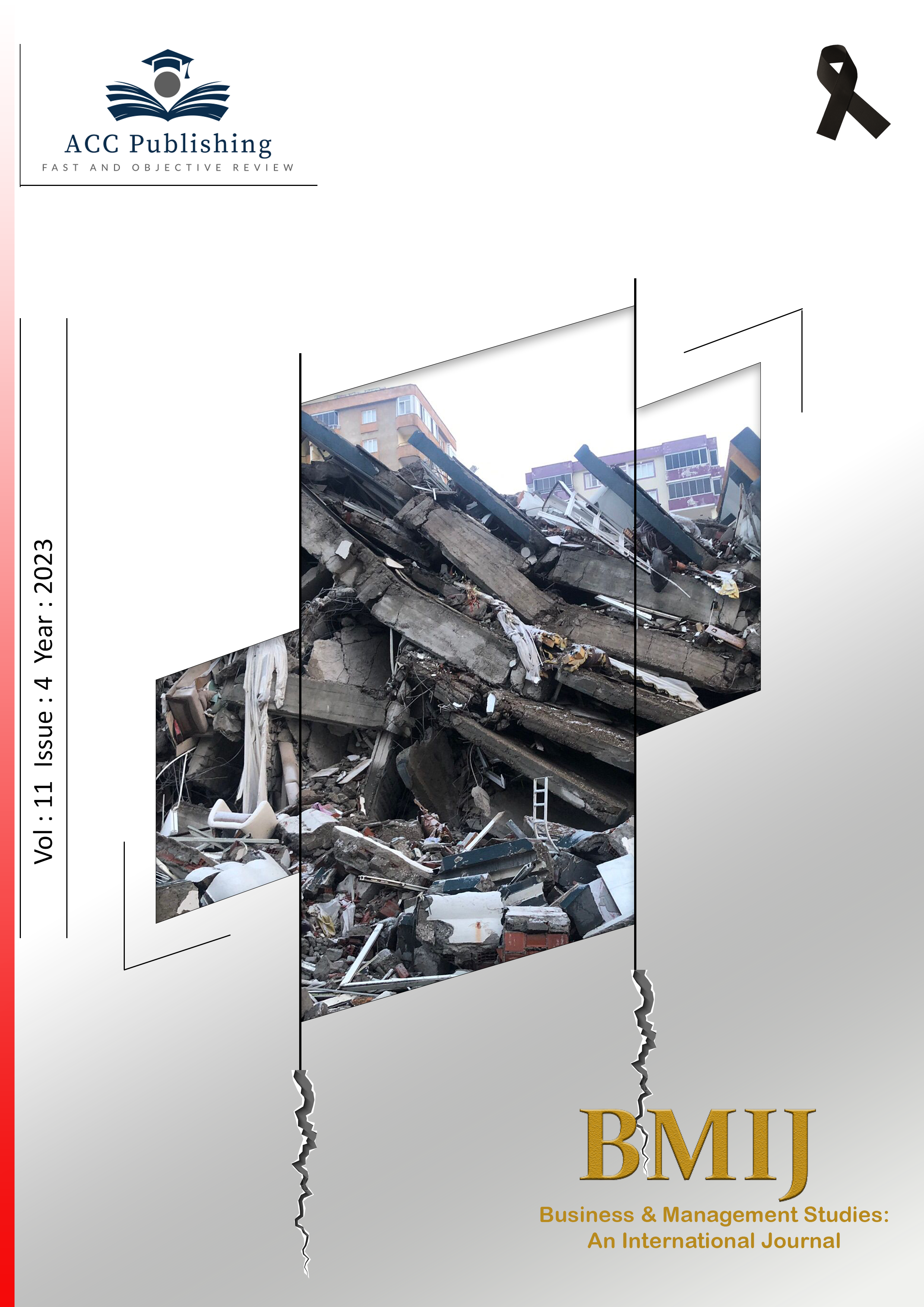
Published 2023-12-25
Keywords
- Ağ Analizi, Non-Local Merkeziyet Ölçüleri, Açık İnovasyon, Dijital Dönüşüm, Strateji ve Yönetim
- Network Analysis, Nonlocal Centrality Measures, Open Innovation, Digital Transformation, Strategy and Management
How to Cite
Copyright (c) 2023 AYSE ASLI YILMAZ

This work is licensed under a Creative Commons Attribution-NonCommercial-NoDerivatives 4.0 International License.
Abstract
This study explores the complex domain of open innovation, a conceptual framework in which the word "open" signifies sharing tacit organisational knowledge. Organisations increasingly expand their scope outside conventional bounds by using open innovation approaches and models to acquire necessary resources. The main aim of this academic undertaking is to examine informal networks that arise outside traditional contractual agreements and then analyse the tangible structure of these networks. The study's primary objective is to thoroughly examine, compare, and analyse nonlocal centrality measures, including global and local viewpoints, within a conceptual framework. This research investigates the utilisation of network analysis methodologies, such as Degree Centrality, Closeness Centrality, Eigenvector Centrality, Betweenness Centrality, Modularity, Community Detection, Vote Rank, and Digital Flaneurs, through the implementation of the Python NetworkX Programming Language. This research highlights its conceptual relevance as a significant and considerable addition to the current body of knowledge. This study provides a fundamental basis for further investigating and comprehending the complex interplay of nonlocal centrality measurements, dynamic capabilities, and open innovation tactics. Therefore, this study is a noteworthy contribution to the scholarly body of knowledge, presenting useful perspectives on the complex relationship between open innovation approaches, dynamic capabilities, and nonlocal centrality measurements. Furthermore, this research adds to the wider scholarly discourse on how organisations effectively manage the intricate challenges of the modern digital environment to achieve innovation and maintain a competitive edge.
Downloads
References
- AKAL, Ş. (2014). Gerçek ve Model Ağlarin Karakteristik Özelliklerinin Karşilaştirilmasi - Comparison of Characteristics Of Real And Modelled Networks. Öneri Dergisi. 11. 251. 10.14783/od.v11i41.5000011416.
- Al-Taie, M.Z., Kadry, S. (2017). Theoretical Concepts of Network Analysis. In: Python for Graph and Network Analysis. Advanced Information and Knowledge Processing. Springer, Cham. https://doi.org/10.1007/978-3-319-53004-8_1
- Baskici, C. & Ercil, Y. (2018). Örgütlerin Ağ Perspektifinden Kurumsal Yapi Analizi. Press Academia Procedia, 7 (1), 335-338.DOI: 10.17261/Pressacademia. 2018.910
- Baskici, C., Ercil, Y. (2018). Corporate structure analysis of organizations from a network perspective. Research Journal of Business and Management (RJBM), V.5(3), p.231-237
- Borgatti, S. (2005). Centrality and Network Flow. Social Networks. 27. 55-71. 10.1016/j.socnet.2004.11.008.
- Borgatti, S.P & Foster, P.C. (2003). A network paradigm in organizational research: A review and typology. Journal of Management, 29 (6):991-1013.
- Chen, H., Mehra, A., Tasselli, S. & Borgatti, S. (2022). Network Dynamics and Organizations: A Review and Research Agenda. Journal of Management. 10.1177/01492063211063218.
- Díaz-Fernández, M., López-Cabrales, A.&Valle-Cabrera, R. (2014): A contingent approach to the role of human capital and competencies on firm strategy, BRQ Business Research Quarterly, ISSN 2340-9436, Elsevier España, Barcelona, Vol. 17, Iss. 3, pp. 205-222, https://doi.org/10.1016/j.brq.2014.01.002
- Emmerik, R., Ducharme, S., Amado, A. & Hamill, J. (2016). Comparing dynamical systems concepts and techniques for biomechanical analysis. Journal of Sport and Health Science. 5. 1-11. 10.1016/j.jshs.2016.01.013.
- Faith, B., Hernandez, K. and Beecher, J. (2022), IDS Policy Briefing 202, Brighton: Institute of Development Studies
- Fortunato S., (2010) “Community detection in graphs”, Physics Reports, 486(3-5):75-174.
- Fortunato, S. & Castellano, C. (2008). Community Structure in Graphs. Encyclopedia of Complexity and System Science. 10.1007/978-0-387-30440-3_76.
- Gençer, M. (2017). Sosyal Ağ Analizi Yöntemlerine Bir Bakış. Yildiz Social Science Review,3(2),19-34. Retrieved from https://dergipark.org.tr/tr/pub/yssr/issue/ 33542/334638
- Golbeck J. (2013). Analyzing the Social Web (1st. ed.). Morgan Kaufmann Publishers Inc., San Francisco, CA, USA.
- Goldenberg, D. (2019). Social Network Analysis: From Graph Theory to Applications with Python. 10.13140/RG.2.2.36809.77925/2.
- Hütt, Marc-Thorsten & Jain, Mitul & Hilgetag, Claus & Lesne, Annick. (2012). Stochastic Resonance in Discrete Excitable Dynamics on Graphs. Chaos, Solitons & Fractals. 45. 611-618. 10.1016/j.chaos.2011.12.011.
- Iacobucci, D., McBride, R., Popovich, D. and Rouziou, M., (2019). In Social Network Analysis, Which Centrality Index Should I Use? Theoretical Differences and Empirical Similarities among Top Centralities. Journal of Methods and Measurement in the Social Sciences, Vol. 8, No. 2, 72-99, 2017, Available at SSRN: https://ssrn.com/abstract=3425975 or http://dx.doi.org/10.2139/ssrn.3425975
- Jong K. C&Chung-in M.(2010), Understanding Northeast Asian regional dynamics: inventory checking and new discourses on power, interest, and identity, International Relations of the Asia-Pacific, Volume 10, Issue 2, May 2010, Pages 343–372, https://doi.org/10.1093/irap/lcq003
- Linss, V. & Fried, A. (2010). The ADVIAN® classification - A new classification approach for the rating of impact factors. Technological Forecasting and Social Change. 77. 110-119. 10.1016/j.techfore.2009.05.002.
- López-Fernández, L., Robles, G., Gonzalez-Barahona, J. M., & Herraiz, I. (2006). Applying Social Network Analysis Techniques to Community-Driven Libre Software Projects. International Journal of Information Technology and Web Engineering, 1(3), 27–48. https://doi.org/10.4018/jitwe.2006070103
- Natalie R. Smith, Paul N. Zivich, Leah M. Frerichs, James Moody, Allison E. Aiello, (2020) “A Guide for Choosing Community Detection Algorithms in Social Network Studies: The Question Alignment Approach”, American Journal of Preventive Medicine, 59(4): 597-605.
- Newman M. E. (2006). Modularity and community structure in networks. Proceedings of the National Academy of Sciences of the United States of America, 103(23), 8577–8582. https://doi.org/10.1073/pnas.0601602103
- Pazura, P., Bortko, K., Jankowski, J., Michalski, R. (2020). A Dynamic Vote-Rank Based Approach for Effective Sequential Initialization of Information Spreading Processes Within Complex Networks. In: et al. Computational Science – ICCS 2020. ICCS 2020. Lecture Notes in Computer Science (), vol 12137. Springer, Cham. https://doi.org/10.1007/978-3-030-50371-0_47.
- Pfeffer, J. (2014). Book Review: Social Network Analysis with Applications. Connections, 34(1). https://doi.org/10.17266/34.1.11
- Turnbull, L., Hütt, MT., & Ioannides, A.A. (2018). Connectivity and complex systems: learning from a multi-disciplinary perspective. Appl Netw Sci 3, 11 (2018). https://doi.org/10.1007/s41109-018-0067-2
- Wasono, L.W., Mihardjo, Sasmoko, & Alamsyah, F. (2022). Boosting the Firm Transformation in Industry 5.0: Experience-Agility Innovation Model. International Journal of Recent Technology and Engineering.


